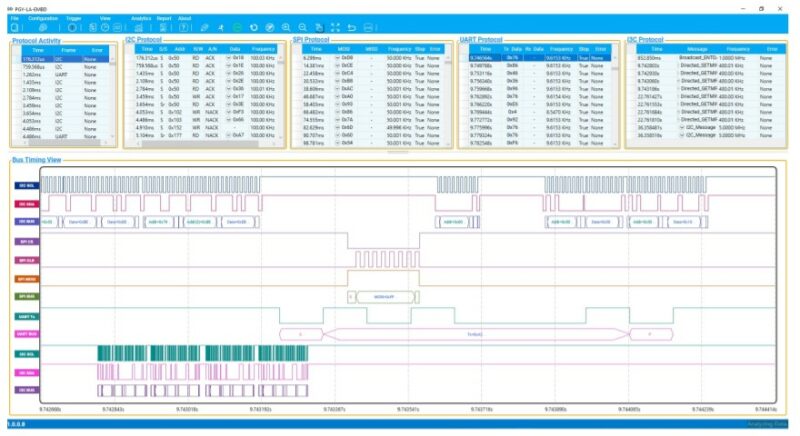



UFS 4.0 Protocol Analyzer
Product
Overview
Datasheet
Presentation
Application
Notes
PGY-UFS4.0-PA, UFS Protocol Analyzer is the industry-first working and tested UFS4.0 Protocol Analyzer. It offers protocol data capture and debugging of data across MPHY, UniPro, and UFS protocol layers. It allows for instantaneous decoding of UFS, UniPro, and MPHY layers with the flexibility to correlate decoded data across these protocol layers. PGY-UFS4.0-PA supports PWMG1 to HSG5B data rates and two TX, and two RX lane decode. The active probe has minimum electrical loading on the device under test (DUT) and captures protocol data without affecting the performance of DUT. PGY-UFS4.0- PA Protocol Analyzer supports two-lane data. Comprehensive on the fly decoding of UniPro & UFS data enables validation of communication between UFS host and device.
PGY-UFS4.0-PA Protocol Analyzer allows Design and Test Engineers to obtain deep insight into UFS host and device communication. MPHY/UniPRO/UFS packet-based triggering allows specific protocol data capture and analysis. PGY-UFS Protocol analyzer instantaneously provides decoding of UFS, UniPro, and MPHY layers with a correlation to MPHY, UniPro, and UFS layers.
Logic Analyzer for Embedded Interfaces DataSheet
Key features
- 16 channels with Protocol and Logic Analysis capability.
- 1GS/Sec Timing (Asynchronous) Analysis.
- 100MHz State (Synchronous) Analysis.
- Simultaneous Protocol Analysis of I2C-SPI-UART and I3C-SPMI-RFFE and CAN, CAN-FD.
- Detailed Trigger capabilities: Auto, Pattern, Protocol aware (I2C, SPI, UART, I3C, SPMI, RFFE, CAN) and Timing (Pulse Width and Delay Trigger).
- Smart streaming of data from Protocol Analyzer to host computer for long duration capture using USB 3.0 interface.
- Innovative easy to use Graphical user interface.
- Error Analysis of Protocol packet.
- Provides Timing, Waveform, Listing and Protocol listing views.
- Detailed filtering capability for protocol decoded data.
- PDF and CSV report format.
- API support.


Test Setup

Easy to Configure

Users can easily configure the Logic Analyzer for embedded interfaces by either selecting Logic Analysis(LA) mode or Protocol Analysis (PA) mode or a combined (LA+PA) mode. This ensures a quick and easy way to configure the product and look at complex problems at the system level either in Logic Analysis (State Analysis, Timing Analysis), Protocol decoding, or both. Save and Recall capability ensures designers can recall their custom setup details.
Multiple Domain
Multiple domain Views provide the necessary complete view of all supported interface states, timing, and protocol activity. Users can easily set up the analyzer to view timing, and logic and decode views to enable easy insights into the design. Users can set different trigger conditions from the setup menu to capture Timing and Protocol activity at specific events. The decoded results can be viewed in Timing, Logic, and Protocol listing window with autocorrelation. This comprehensive view of information makes it the industry’s best, offering an easy-to-use solution to debug the embedded interfaces protocol activity and analyze timing issues. Multiple cursors help designers to look into details of their design performance.
Timing View
Timing view is a unique capability of the PGY-LA-EMBD which enables designers to get detailed insights into their signals’ timing information. The timing view uses an internal clock signal to plot the waveform. The flexible sampling rate selection enables designers to investigate Glitches that can cause issues in the functioning of their designs. The grouping feature enables designers to group various related signals for better viewing and analysis. Marker and Zoom features make it convenient to analyze any timing errors. The ability to analyze any point in the captured data record ensures easy debugging and analysis over a long capture duration.

State View/Waveform Listing View
State view helps designers to see the actual signal behavior. Using the device clock as a reference, it provides the plot of the clock and data signals with a bus diagram. Grouping of signals ensures designers have the flexibility to view signals together. All signals are time-correlated to help look into setup and hold times, pulse width, missing data, etc. which are very critical for digital designs as designers look to optimize their codes.

Protocol Decode View
The protocol Activity window provides the decoded packet information in each state and all packet details with error info in the packets. This gives system-level insight to the design teams. The individual protocol decodes windows based on selected interfaces ensuring easy viewability for design teams. The selected frame in the Protocol listing window will be autocorrelated in the timing view to view the timing information of the packet. Protocol errors will be highlighted to ensure designers are alerted to the same easily.


Powerful Trigger Capabilities
PGY-LA-EMBD supports Auto, pattern, Protocol awareness, and timing parameter trigger capabilities. Users can trigger any of the Protocol packets. Comprehensive Trigger provides the flexibility to monitor different conditions.

Analytics
Detailed analytics on the various protocol to enable better analysis and provide additional insights to designers.
Report
The report can be generated in PDF or CSV format with details of all the signal information, plots, and custom details like the name of the company, logo, tester name, date, and time to ensure designers can document all details and share the report.

Key Specifications
Specifications




